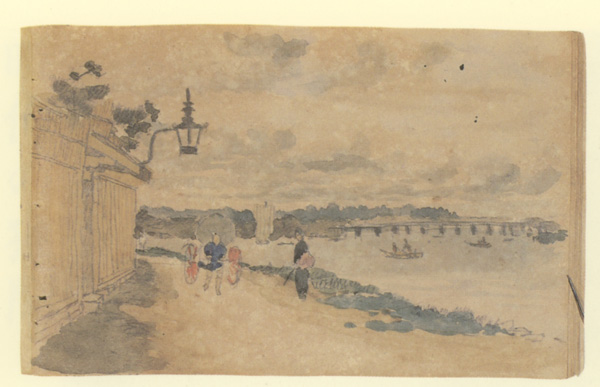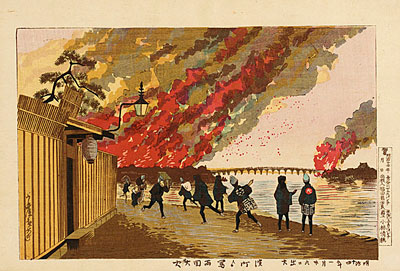About This Print
This print was made in the 1950s by the Kyoto publisher Maria Shobo from recut woodblocks, copying the original 1881 design. Two series of Kiyochika designs, each consisting of 12 prints, were issued. The recut prints generally, but not always, have the publisher's identifying Ma character beneath the cartouche in the print's margin. Maria Shobo wasestablished in 1924 and continues to publish books.This print was originally issued as part of a loosely constructed series Famous Views of Tokyo (Tokyo meisho) consisting of 93 prints issued from 1876-1881 by two publishers, Matsuki Heikichi and Fukuda Kumajirô. For additional information on this series see "Early Woodblock Prints: The Series Famous Views of Tokyo (Tokyo meisho) 1876-1881" on the Kobayashi Kiyochika (1847-1915) page.
Kiyochika and Fire
Source: Kiyochika: Artist of Meiji Japan, Henry D. Smith II, Santa Barbara Museum of Art, 1988, p. 52-53The logical extreme of Kiyochika’s preoccupation with light was his attraction to the large fires that periodically swept the city of Tokyo. His sketchbooks record at least four different conflagrations, each quite spectacular. Not until two successive fires in early 1881, however, were Kiyochika’s sketch records turned into prints, creating some of the most dramatic and popular works in the entire Tokyo series.
At around 2 a.m. on January 26, 1881, fire broke out in Kanda Matsueda-cho, just one-half mile west of Kiyochika’s house near the west end of Ryogoku Bridge. Probably the work of an arsonist, the fire spread rapidly, fanned by strong seasonal winds from the northwest. Probably around daybreak, it reached the foot of Ryogoku Bridge, consuming Kiyochika’s home. The fire was then driven across the Sumida River to the Honjo area, traveling south to Fukagawa until it finally burned out in the early evening of the same day after sixteen hours of devastation. The greatest of all the many fires in Meiji Tokyo, it destroyed over 10,000 buildings.
In the case of Ryogoku Fire Sketched from Hamacho, Kiyochika did in fact work from a sketch (see below)– but from one made months earlier of the same place on an ordinary day. To this design he added the appropriate flames, which were themselves taken from another of his earlier sketches.
For a detailed analysis of this print and its related sketch see Henry D. Smith II's article "From Sketch to Print: Kiyochika's Ryogoku Fire and Hakone-Shizuoka Prints" at http://www.columbia.edu/~hds2/pdf/1991c_Kiyochika_sketchbooks.pdf
Source: Imperial Japan: The Art of the Meiji Era (1868-1912), FrederickBaekeland, Herbert F. Johnson Museum of Art, Cornell University, 1980, p. 126
Due to the light wooden construction of its houses, throughout the Tokugawa period, Edo was subject to fires, some of them devastating, and this remained true, to a slightly lesser extent, of Meiji Tokyo. Kiyochika made his name with his brilliant pictorial reportage of two such fires that occurred in 1881. The first started about 8 PM in Matsueda in Kanda. Fanned by a wind, it burned down to the banks of the Sumida River and skipped to the opposite bank. Kiyochika immediately grabbed a sketchbook and dashed out to spend the night sketching the fire. The story goes that he later discovered his house had burned down, and his negligence made his wife leave him. In any event, his interest in the light effects afforded by a fire reminded us of the English painter Joseph Mallord William Turner's (1775-1851) fascination with painting the burning Houses of Parliament in London.
This gripping print has the immediacy of a snapshot. The accurately observed figures on the river bank run along with boxes or bags full of possessions on their backs or else stand and watch the flames and smoke rising in the rose sky down and across the river. The symmetrical composition, with a repoussoir building on the left leading the eye to the distant flames and water, is a completely satisfying one that fuses brilliant color and melodrama.
Print Details
| IHL Catalog | #23 |
| Title or Description | Scene of Big Fire at Ryogoku from Hama-cho (Hamacho Yori Utsusu Ryogoku Taika 浜町より写す両国大火) |
| Series | Famous Views of Tokyo (Tokyo meisho) |
| Artist | Kiyochika Kobayashi (1847-1915) |
| Signature |  |
| Seal | none |
| Publication Date | originally 1881 (Meiji 14) by Fukuda Kumajirô. This print c. 1950 |
| Publisher |  |
| Edition | c. 1950s from recut blocks |
| Impression | excellent |
| Colors | excellent |
| Condition | excellent |
| Genre | ukiyo-e; meisho-e; fukusei-ga |
| Miscellaneous | Inscription bottom right margin reads "Outbreak of fire on January 26, 1871 [note: date is incorrect should be 1881] |
| Format | horizontal oban |
| H x W Paper | 9 1/4 x 13 7/8 in. (23.5 x 35.2 cm) |
| H x W Image | 8 1/4 x 12 3/4 in. (21 x 32.4 cm) |
| Literature | Kiyochika: Artist of Meiji Japan, Henry D. Smith II, Santa Barbara Museum of Art, 1988, p. 50, fig. 4; Imperial Japan: The Art of the Meiji Era (1868-1912), Frederick Baekeland, Herbert F. Johnson Museum of Art, Cornell University, 1980, p. 126, pl. 65. |
| Collections This Print | Los Angeles County Museum of Art M.71.100.149 (1881 printing); Santa Barbara Museum of Art 1986.31.12 (1881 printing); Museum of Fine Arts Boston 63.780 (1881 printing); Chazen Museum of Art 1980.2484 (1881 printing) |
3/9/2020




